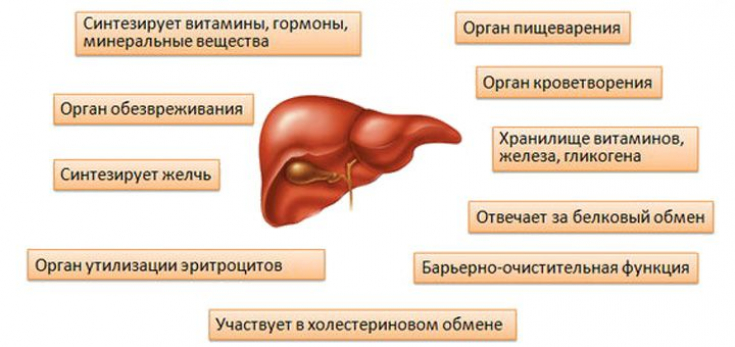Doctors began to warn about the dangers of alcohol for the liver at the beginning of the last century, when the relationship between excessive drinking and dropsy" (ascites), fatty liver disease (steatohepatosis) and other diseases. But things are still there: according to the results of various studies, from 26% to 48% of the total population of the Earth in one way or another suffers from liver pathologies caused by excessive consumption of alcoholic beverages.
Therefore, information about how alcohol affects liver will help you decide: is it worth a second or third glass of martini in evening to ruin your health once and for all.
- How alcohol affects the liver and who is at risk
- How to Reduce Your Liver Risks When Drinking Alcohol
How alcohol affects the liver and who is at risk
Today, the effect of ethanol (a key component of any alcoholic beverage) on human health has been studied quite well. But with regard to the liver, the picture to some extent continues to be "mysterious". This is easily explained by the difference in the quality of the alcohol consumed, the peculiarities of the functions of the liver in different people, the initial state of this organ, and many other circumstances.
Furthermore, excessive alcohol consumption is rarely combined with a healthy diet or a healthy lifestyle in general. Therefore, in some cases it is difficult to determine: what exactly became the "last straw" for the liver: poor nutrition, excessive alcohol consumption, prolonged household or industrial intoxication (contact with toxic compounds that penetrate into the bloodstream) or a combination of all factors.

But in the course of clinical studies, a mechanism for the development of liver pathologies under the influence of alcohol has been revealed. The greatest danger is acetaldehyde — a substance that is formed in the process of splitting and utilization of ethanol. This is a highly toxic compound that causes the death of hepatocytes — functional liver cells. As the attack of acetaldehyde on the liver continues, the destroyed hepatocytes begin to be replaced by fat cells, which, naturally, are unable to perform the same functions as liver cells. And with prolonged use of alcohol in excessive amounts, liver tissues begin to transform into connective tissue, forming scars.
Read also: The harm and benefits of alcohol: is it necessary to completely exclude alcohol from life
At this stage, the process becomes irreversible. With an early visit to the doctor, you can stop the pathological process, but reverse it — it is forbidden. The only way to maintain liver function at a satisfactory level — it is to completely change the way of life, carefully monitor nutrition and with with a certain regularity undergo a course of medical treatment.
Unfortunately, the visit to the doctor most often occurs at an advanced stage, when the liver has undergone serious changes, the portal vein, gallbladder were involved in the pathological process, and the metabolism has broken down to a critical level.

It is important to remember that "alcoholic" changes in the liver in most cases are asymptomatic, so be sure to undergo regular preventive examinations if you are in the high-risk group:
-
Consume more than 60 ml of strong drinks or 700 ml of weak drinks more often 2-3 times week (for women it is 30 ml and 350 ml respectively).
-
Your family has a history of alcoholic hepatosis, steatohepatitis, cirrhosis, or other non-communicable liver disease.
-
In the past, you had viral hepatitis or surgery on the liver or gallbladder.
-
You are overweight.
-
Your diet is far from healthy and ready-to-eat foods predominate in your diet (canned food, sausages and bakery products, etc.).

Read also: Diet for liver disease: what you can and not to eat
Also, special attention to the health of the liver should be given to those who, for some reason, have reduced immunity and those who are often exposed to biological or chemical intoxication (smokers, people prone to frequent SARS and SARS, employed in & nbsp; ;"harmful" production, living in environmentally disadvantaged regions).
How to reduce liver risks from alcohol consumption
Answer "completely give up alcohol" unlikely to satisfy anyone. But you can not resort such drastic measures and keep your liver healthy if you follow the following rules:
-
Give your liver a break. After drinking alcoholic beverages, you should refrain from repeated libations for at least 2-3 days. This period takes into account the permissible single doses (30/60 ml of strong and 350/700 ml of weak alcoholic drinks — for women and men respectively). If for some reason you drank more, the recovery period also increases.
-
Keep an eye on your diet. A balanced diet, which is dominated by fresh and cooked vegetables and fruits, cereals from whole grains, helps to maintain the metabolism at the correct level and reduces the load on the liver.
-
Use enterosorbents. These are over-the-counter drugs that bind or absorb some of the toxins in the intestinal lumen, which facilitates the work of the liver and minimizes the "toxic hit" after drinking alcohol.
And, of course, regularly, at least 1 time per year (or 1 time 3-6 months, if you frequently resort to alcohol) get examined by doctor. Minimal diagnostic complex — a biochemical blood test and ultrasound of the liver will allow you to identify unwanted changes at the initial stage and treat before the liver is seriously damaged.
Read also: Cholelithiasis: symptoms, treatment, prevention
You might be interested in: Abs Workouts.








Add a comment